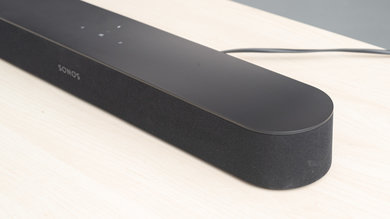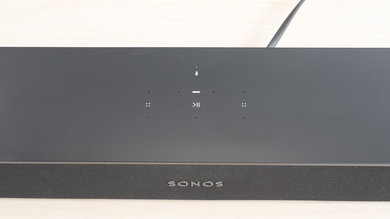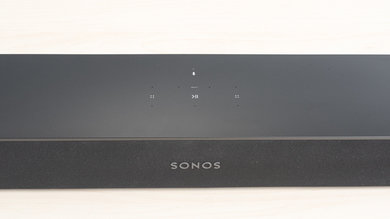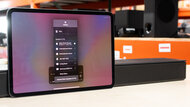The Sonos Beam is a 3.0 soundbar with a small, compact design. It's a smart soundbar with built-in voice assistant support that you can easily add to your Sonos ecosystem using the Sonos S2 app. Like other premium bars on the market, it comes with a room correction feature to optimize audio reproduction based on your room's unique acoustics - though this feature is only available with iOS devices. While the standalone bar struggles to reproduce the deep, bassy rumble, you can always add on a separate subwoofer to improve its bass reproduction as well as satellites to improve its surround sound.
Our Verdict
The Sonos Beam soundbar is fair for mixed usage. Its neutral and accurate mid-range makes it ideal for listening to vocal-centric content like podcasts and TV shows. Vocals and lead instruments in your favorite music reproduce clearly, too, but you don't feel the rumble in the bass with bass-heavy genres like hip-hop and EDM. Though the bar can play surround sound, it doesn't offer a very immersive listening experience as a standalone bar. There's no Atmos support, either.
- Very well-built design.
- Easily upgradable setup.
- No Atmos support.
- No Full HDMI In ports.
The Sonos Beam is very good for dialogue-heavy content like TV shows. With its discrete center channel, this 3.0 setup anchors voices to a pinpoint location in the soundstage. Its balanced mid-range ensures that dialogue reproduces clearly and accurately, and there's extra brightness in the treble to make higher-pitched voices sparkle. You can even use its dialogue enhancement feature to make voices more clear and crisp if you prefer.
- Dialogue enhancement tool.
- Great center channel performance for dialogue in movies.
- No Full HDMI In ports.
The Sonos Beam soundbar is decent for music. It has a room correction feature - which Sonos calls TruePlay - that adjusts its audio reproduction based on your room's unique acoustic characteristics. With this feature on, it has a balanced mid-range that makes vocals and lead instruments clear and present in the mix, and there's extra brightness in the treble to make higher-pitched vocals sparkle. If you want a different sound, you can customize it with its bass and treble adjustments. However, you need to add a separate subwoofer to feel the deep rumble in bass-heavy genres like EDM and hip-hop.
- Wide soundstage.
- Lacks rumbling low-bass.
The Sonos Beam soundbar is passable for movies. The bar supports surround sound like Dolby Digital and DTS, but it has to downmix it into stereo to play it. It doesn't sound as immersive as setups with discrete satellites, but fortunately, you can add on separate satellites from Sonos if you watch lots of movies. However, you'll also need to add a subwoofer to feel the rumble in the low-bass during action-packed scenes.
- Great center channel performance for dialogue in movies.
- Easily upgradable setup.
- Wide soundstage.
- Lacks rumbling low-bass.
- No Atmos support.
- Poor surrounds performance.
Changelog
- Updated Jan 17, 2024: We've updated this review's text to ensure its accuracy and clarity.
- Updated Jun 13, 2023: Converted to Test Bench 1.2. Updated the results for audio format support via ARC/eARC, HDMI In, and Optical. Added Video Passthrough to TV results as well.
- Updated Mar 20, 2023: Added cable lengths to In The Box.
- Updated Mar 16, 2023: Converted to Test Bench 1.1. With this update, we've added a Mounting test and added information aboutSubwoofer Output, Spotify Connect, and Microphone Mute.
Check Price
Differences Between Sizes And Variants
The Sonos Beam comes in one color variant: 'Black'. Some retailers sell a version of this product known as the Sonos 'Beam Shadow' or the Sonos 'Beam Shadow Edition' soundbar, which is in a gray color scheme. While we haven't tested them, we expect them to be the same product and perform comparably in tests.
The second generation of this soundbar came out in 2021. You can see our review for the standalone Sonos Beam (Gen 2) or for the Sonos Beam (Gen 2) with Sub Mini + One SL Speakers.
If you encounter a variant not listed here, let us know in the forums, and we'll update our review.
Popular Soundbar Comparisons
This bar's small, compact size packs a decent performance that can be easily upgraded down the line, thanks to its separate subwoofer and satellites. Its side-firing speakers also help ensure a wide soundstage. Unfortunately, it lacks Bluetooth connectivity, and like many small, standalone soundbars, it has a limited amount of inputs. Unlike its successor, the Sonos Beam (Gen 2), it doesn't support Dolby Atmos either, but it can still be a good choice if you're looking for a bar to handle podcasts or music.
If you're still looking for more soundbars, check out our recommendations for the best small soundbars, the best soundbars for dialogue, and the best Dolby Atmos soundbars.
The Sonos Beam is better than the Sonos Ray. The Beam is a 3.0 setup, meaning it has a discrete center channel to improve dialogue reproduction, unlike the Ray. It can reproduce a bit more rumble in the bass range, and its soundstage offers a much wider, more immersive listening experience. There's also an HDMI input, which the Ray lacks.
The Sonos Arc is more versatile than the Sonos Beam since it supports eARC and Atmos content. The Arc can deliver deeper bass and has better surround and height performances. That said, the Beam performs better at max volume. It's also shorter and much easier to fit between the legs of a 55-inch TV.
The Sonos Beam is a better soundbar than the Sonos Playbar. The Beam has a more neutral sound profile and a sleek, compact design. It also supports ARC via an adapter and is Apple AirPlay compatible.
The Sonos Beam is a better soundbar than the Bose TV Speaker. The Sonos is a 3.0 setup with a better surround performance. It comes with more sound enhancement features, it can get loud enough for a large room, and you can stream music wirelessly to it using Wi-Fi or Apple AirPlay. It also has a companion app that can control all the bar's features. However, the Bose is a 2.0 setup that lets you use Bluetooth to play audio from your phone. The Bose also has an auto-off power-saving feature.
Test Results

This bar doesn't include a subwoofer. However, you can purchase a separate subwoofer to upgrade your setup.
This bar has no satellites, but you can upgrade your setup with additional satellites.
This bar has great build quality. It's mostly plastic, which feels very robust and solid. Unlike the Sonos Beam (Gen 2), however, it has a fabric cover to protect the drivers instead of a plastic grille. This design choice makes the bar prone to collecting dust and coming loose over time.
The Sonos Beam's stereo frequency response is decent. Like many premium bars on the market, it comes with a room correction feature to adjust its sound based on your room's unique acoustics—Sonos calls this feature TruePlay. It's worth noting that this feature is only available on iOS devices.
With room correction on, its sound profile is fairly well-balanced, producing a bright yet neutral sound. Updating the bar to firmware version 14.18 adds some extra emphasis in the treble, too, so vocals and instruments sound crisp and detailed while sibilants like cymbals sizzle. This sound is ideal for dialogue-centric content without a lot of bass, like podcasts and TV shows. That said, like most standalone soundbars, it can't reproduce the deep thump and rumble in the bass range, which can make action-packed scenes and musical genres like EDM and hip-hop feel lacking. You can improve its bass reproduction by adding on Sonos' separate subwoofer, though.
There are bass and treble adjustments in this bar's companion app, so you can customize its sound. With the bass set to '0' and the treble set to '-6', dialogue and instruments become less harsh without losing their detail or clarity. It still lacks the deep rumble in the low-bass, even when you adjust its bass.
This soundbar has a great soundstage. Its side-firing speakers work together with its center channel speaker to produce a soundstage that feels almost as wide as home theater speaker towers. However, you can't disable this setup, and while this soundstage widening effect works well, it feels like the sound is coming from a general area rather than a specific location. If you're looking for a soundbar with a wider soundstage, check out the Bose Smart Soundbar 700.
This soundbar gets fairly loud, so it can still fill an average-sized living room with sound. However, some compression artifacts are present at max volume, especially in the bass range. These compression artifacts persist, even after updating the bar to firmware version 14.18. As a result, cranking up the volume results in a sound that isn't as clean or pure as at lower volumes.
This soundbar's THD performance is decent. There isn't much distortion present at a normal listening volume, resulting in a clear and pure sound. That said, there's a slight increase in THD at max volume, even after updating the bar to firmware 14.18. Distortion is hard to hear with real-life content, but astute audiophiles will want to keep it in mind.
This soundbar is a 3.0 setup with a great center channel performance. It has a dedicated center speaker that improves vocal reproduction overall. Its sound profile is pretty balanced, too, especially in the mid-range, where most voices reproduce. However, updating the bar to firmware 14.18 adds extra brightness to the mix, which you may want to adjust with its treble dial to get a more even sound. Also, it lacks some low-bass, but this isn't noticeable with dialogue-centric content since voices aren't usually reproduced in the bass range.
As expected, this 3.0 setup has a poor surround performance. As a standalone bar, it downmixes everything into a stereo signal while using the left and right speakers to produce its surround sound. It struggles to produce an accurate and clear representation of surround objects like dialogue or individual instruments in an orchestra, which feel like they're coming from in front of you rather than around you. Luckily, as the L/R drivers are on the side of the bar, it can make the surround experience slightly better. You can also upgrade this soundbar with separate satellites to improve its surround performance. If you mostly listen to surround and Atmos content, you'll want to check out the Nakamichi Shockwafe Ultra 9.2Ch, which produces a much more dimensional surround experience.
This setup doesn't support Dolby Atmos content. If you want a small bar with Atmos support, check out the LG Eclair QP5 or the Sonos Beam (Gen 2). There are other standalone bars with Atmos support, too, like the Bowers & Wilkins Panorama 3.
The Sonos Beam doesn't offer a lot of customizability like an EQ or presets, but you can adjust the bass and treble if you like to tweak your sound. There's a dialogue enhancement feature for producing clearer speech and a night mode for adjusting the volume level of different content as it changes. It also offers a room correction feature that automatically adjusts the sound profile to the acoustics of the room it's in, although it's only available on the iOS app. If you want a small soundbar with a graphic EQ, check out the Samsung HW-S60A.
This soundbar has a limited amount of physical inputs. It has an ethernet port and an HDMI ARC in port. While limiting, you can use the HDMI ARC in port with external devices that have an Optical Out by using the HDMI to Optical adapter included in the box. If you're looking for a 3.0 setup with more physical inputs, consider the Bose Smart Soundbar 300.
This bar supports surround sound via its HDMI ARC port. Unfortunately, it only supports Dolby Digital and DTS content, which you'll often find on Blu-rays and streaming platforms. This bar can't play back object-based sound formats like Dolby Atmos or DTS:X.
If you want a small soundbar with a Full HDMI In port, check out the JBL Bar 5.0 MultiBeam.
This soundbar can play back Dolby Digital and DTS surround sound, which is common in Blu-ray discs and streaming media. It uses its Optical out connection via its included HDMI to Optical adapter.
The Sonos Beam has an outstanding latency performance. It has low latency via its ARC and Optical ports, making it suitable for watching videos and movies. Some apps and TVs compensate for latency differently, so your real-world experience may vary.
Unlike the Vizio M-Series M21d-H8R, this bar doesn't have a Full HDMI In port, so it doesn't support video passthrough to devices such as a TV.
While this bar lacks Bluetooth connectivity, it can connect to external devices using Wi-Fi. Some apps like Spotify have direct support built-in, so you can easily cast your favorite songs from your mobile device. If you have an iOS device, you can also cast using Apple AirPlay. If you have the Sonos app, it connects you to several music sources that you can use to play audio.
































